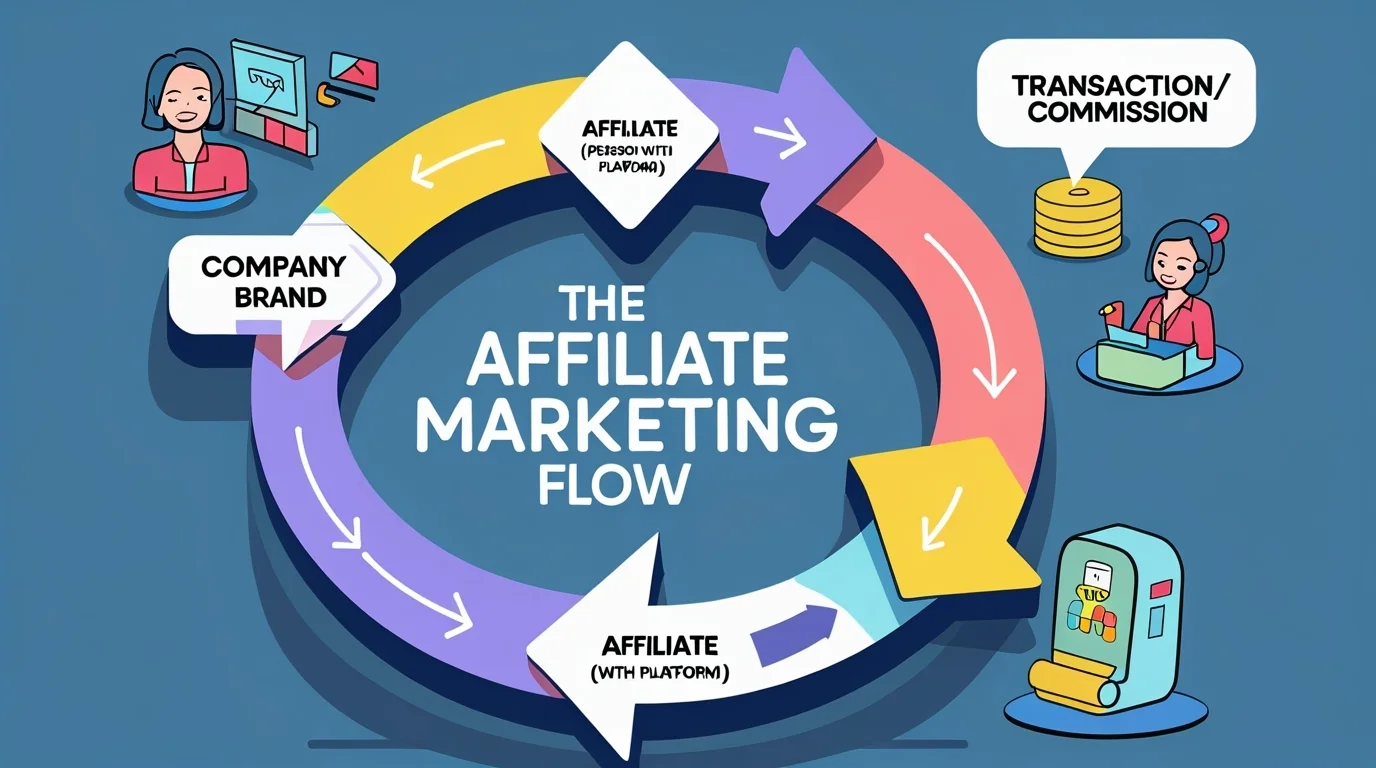Are you in search of a scalable and flexible online income stream that allows you to focus on your creative pursuits or expand your main business? Affiliate marketing might just be the powerful answer you’ve been looking for. Imagine this: you genuinely recommend products or services you love and use, share a unique tracking link, and earn money every time someone makes a purchase through your referral. Sounds straightforward, right? That’s because, at its core, it is!
This comprehensive guide will walk you through everything you need to know about affiliate marketing—from pinpointing your perfect niche and selecting the right programs to building a compelling platform, crafting engaging content, driving targeted traffic, and strategically optimizing your earnings for long-term success. Whether you’re an aspiring blogger, a seasoned content creator, an eager entrepreneur, or simply someone looking to monetize content and build a steady passive income stream, affiliate marketing offers an exceptional pathway to online business growth.
Could you please explain what affiliate marketing is?

Affiliate marketing is a performance-based marketing strategy where you (the "affiliate" or "publisher") earn a commission by promoting another company’s products or services. It's essentially a referral program with a sophisticated tracking system.
Here’s a breakdown of how the process typically works:
The Merchant/Company: A business (the merchant, advertiser, or brand) offers an affiliate program to boost its sales. They provide unique tracking links or codes to their affiliates.
The Affiliate/Publisher: You, as the affiliate, join the program and receive these unique affiliate links. Your role is to promote the merchant's product using these links within your content.
The Customer: A potential customer clicks on your unique affiliate link. This link contains a tracking code that identifies you as a referrer.
The Purchase & Commission: If that customer then makes a purchase (or completes another desired action, like signing up for a free trial) within a specified "cookie window" (a period during which your referral is credited), you earn a commission on that sale.
It's a harmonious win-win-win scenario: businesses gain more customers, affiliates earn money for their impactful referrals, and customers discover valuable products they might not have found otherwise. The inherent beauty of affiliate marketing is that it doesn’t require you to create your own product, manage inventory, handle customer service, or worry about shipping. Your primary focus is solely on attracting an audience and providing genuine value that leads to informed purchases.
Why Should You Start Affiliate Marketing Now?
Affiliate marketing has skyrocketed in popularity, particularly in the digital age, largely due to its incredibly low barrier to entry and its immense potential for scalable, passive earnings. Here’s why it might be the perfect online business opportunity for you:
Unmatched Flexibility: You possess complete control. You can work anytime, anywhere with an internet connection, promoting products that truly align with your interests, expertise, or chosen niche. This empowers you to integrate it seamlessly into your current lifestyle.
Unlimited Scalability: There are virtually no limits to how much you can earn. The more high-quality traffic you drive to your content and the more conversions you generate, the higher your potential commissions. It’s a direct correlation between effort, value, and income.
Zero Product Investment & Management: Unlike traditional businesses, you don’t need to invest capital in product creation, manufacturing, storage, or shipping. You also avoid the headaches of inventory management, order fulfillment, and direct customer support. Your focus remains entirely on promotion and relationship-building.
Low Startup Costs: Getting started can be surprisingly affordable. Your primary investments are typically a platform (like a blog, website, or social media presence) and, most importantly, your time, dedication, and effort in creating valuable content.
Diversified Income Stream: Affiliate marketing can provide a powerful additional source of passive income, reducing your reliance on a single income stream and adding financial resilience.
How to Get Started with Affiliate Marketing: Your Step-by-Step Guide
Now that you comprehend the fundamental principles and significant advantages, it's time to take action and start your affiliate marketing journey! Follow these practical steps to set yourself up for long-term success:
1. Choose Your Niche and Deeply Understand Your Audience

Focus is the bedrock of successful affiliate marketing. Trying to promote everything to everyone leads to mediocrity.
Select a Niche: Start by choosing a niche that genuinely aligns with your interests, expertise, and what you’re passionate about. Your authentic enthusiasm will shine through and build trust with your audience.
Self-Reflection Questions:
What topics do I consistently enjoy learning about or discussing?
What problems do I have unique insights to solve for others?
Is there a discernible market demand for products or services within this topic? (e.g., "sustainable living," "remote work productivity," "pet care for exotic animals," and "budget travel hacks").
Understand Your Target Audience: Once you have a niche, delve deep into understanding who your target audience is.
Demographics: What are their age, location, and income level?
Psychographics: What are their pain points, desires, challenges, and aspirations, and what solutions are they actively seeking?
Behavior: Where do they hang out online? What kind of content do they consume?
Knowing your audience intimately allows you to create relevant content and promote products that genuinely meet their needs.
2. Research and Select High-Quality Affiliate Programs
Affiliate programs are the essential bridge connecting you to the companies whose products you’ll promote. Choosing the right programs is critical.
Key Factors to Consider:
Commission Rates: Look for programs offering competitive commission structures. While some might be a flat fee, most offer a percentage of the sale. Understand the payment frequency and minimum payout thresholds.
Product Relevance: The products or services you promote must resonate with your niche and audience. Authenticity is paramount. Promote only products you genuinely believe in and, ideally, have used yourself.
Tracking & Support: A reliable program will provide robust tracking tools to monitor your clicks, conversions, and commissions. Look for clear dashboards and responsive affiliate manager support.
Cookie Duration: This variable is the length of time your referral is credited after someone clicks your link. Longer cookie durations (e.g., 30-90 days) are generally better.
Popular Affiliate Program Types to Explore:
Large Retailer Programs: Amazon Associates is a common starting point due to its immense product variety and widespread trust. While commissions can be low, the conversion rate is often high.
Affiliate Networks: These platforms serve as intermediaries, facilitating connections with thousands of diverse companies. Popular examples include ShareASale, CJ Affiliate (formerly Commission Junction), Impact.com, and Rakuten Advertising. These often offer higher commissions than Amazon.
Individual Brand Affiliate Programs: Many brands (especially in SaaS, online courses, or niche products) run their own direct affiliate programs (e.g., Bluehost for web hosting, specific software companies, online course creators). These often offer excellent commission rates for highly targeted audiences.
High-Ticket Programs: Consider programs for more expensive products or services (e.g., financial software, luxury travel, high-end courses) that offer fewer sales but significantly higher commissions per sale.
3. Build Your Authority Platform
To effectively promote affiliate products and build trust, you need a central hub where your audience can find and engage with your content.
Primary Platform Options:
Blog or Website: Excellent for creating in-depth content like comprehensive product reviews, detailed "how-to" guides, tutorials, comparison posts, and evergreen resource lists. A blog allows for strong SEO and builds long-term authority.
YouTube Channel: Highly visual and engaging, perfect for product demonstrations, unboxings, tutorials, side-by-side comparisons, and personal endorsements. Video content builds strong rapport.
Social Media Accounts: Platforms like Instagram, TikTok, Pinterest, or even LinkedIn can be powerful for "influencer"-style" promotion, promoting lifestyle products, or sharing quick tips with integrated links. Each platform requires a tailored content strategy.
Email Newsletter: Building an email list is crucial for long-term success. It gives you a direct line of communication with your most engaged audience, allowing you to share valuable content and integrate affiliate links directly into their inbox while bypassing algorithmic changes.
Platform Best Practices: Ensure your chosen platform is easy to navigate, visually appealing, and, most importantly, consistently populated with high-quality, valuable content that solves problems or entertains your specific audience.
4. Create High-Value, Authentic Content

The cornerstone of successful affiliate marketing is trust, which is built through authentic, engaging, and genuinely helpful content. Your content shouldn't just be promotional; it should provide tangible value.
Effective Content Ideas:
In-depth Product Reviews: Write (or film) honest, balanced reviews that highlight both the pros and cons, personal experiences, and who the product is best for. This builds credibility.
Comparison Posts/Videos: Directly compare multiple products within your niche, helping your audience make informed decisions (e.g., "Laptop A vs. Laptop B for Video Editing").
"How-To" Guides & Tutorials: Show exactly how a product can solve a specific problem or achieve a desired outcome (e.g., "How to Set Up Your New Streaming Microphone").
Curated Resource Lists: Compile lists of your favorite tools, apps, books, or products that your audience will find genuinely valuable.
Problem/Solution Articles: Identify a common pain point in your niche and present affiliate products as the best solution.
Seasonal/Themed Content: Create gift guides, holiday shopping lists, or "back-to-school" product recommendations.
Crucial Pro Tip: Transparency and Disclosure: Always, without exception, disclose when you are using affiliate links. Place a clear disclaimer at the beginning of your blog posts, in video descriptions, or prominently on social media posts. This builds immense trust with your audience and ensures compliance with Federal Trade Commission (FTC) guidelines and the requirements of most affiliate programs.
5. Drive Targeted Traffic to Your Content
Producing outstanding content is merely half the challenge. To earn commissions, you need to drive relevant traffic—people who are actually interested in what you're promoting—to your affiliate links.
Key Traffic Generation Strategies:
Search Engine Optimization (SEO): For blogs and websites, this is paramount for long-term, passive traffic. Optimize your content with relevant keywords, build high-quality backlinks, and ensure your site is technically sound so search engines like Google can find and rank your pages. This strategy brings in people actively searching for solutions you offer.
Social Media Marketing: Share your content on relevant social platforms where your target audience congregates. Engage with your followers, use relevant hashtags, and provide snippets that entice clicks to your main content.
Email Marketing: Your email list is gold. Send valuable content, exclusive tips, and integrated affiliate links directly to your most engaged subscribers. This type of marketing is a highly effective way to drive conversions.
Paid Advertising: If your budget allows and you understand your conversion metrics, consider using platforms like Google Ads (for search intent) or Facebook/Instagram Ads (for audience targeting) to drive highly targeted traffic to your best-performing affiliate content. Start small and test extensively.
Pinterest Marketing: For visual niches (e.g., home decor, recipes, fashion, DIY), Pinterest acts like a visual search engine and can drive significant long-term traffic to your blog or website.
6. Optimize and Scale Your Earnings Continuously

Affiliate marketing is not a one-time event. It requires continuous testing, analysis, and improvement to maximize your returns and truly build a sustainable passive income stream.
Key Optimization & Scaling Tactics:
Track Your Metrics: Regularly analyze your performance. Monitor key metrics such as
Click-Through Rate (CTR): How many people click your affiliate links versus how many view your content.
Conversion Rate: How many clicks turn into actual sales/commissions?
Earnings Per Click (EPC): How much you earn for every click on your link.
Top-Performing Products/Content: Identify which products and which pieces of content generate the most commissions.
A/B Test Everything: Experiment with different call-to-actions, link placements, content formats, headlines, and even promotional strategies to see what resonates best with your audience and drives higher conversions.
Expand Your Affiliate Partnerships: As your audience grows and your understanding of your niche deepens, explore new, relevant affiliate programs and products. Look for complementary products that your audience would also find valuable.
Revisit & Update Old Content: Your most valuable assets are your existing high-ranking content. Periodically update old blog posts or videos to replace outdated affiliate links, add new product recommendations, and ensure information remains fresh and relevant. This approach keeps your content performing for years.
Common Pitfalls to Avoid in Affiliate Marketing
While affiliate marketing offers immense potential, it’s easy for beginners to make missteps. Steering clear of these common mistakes will accelerate your success:
Promoting Too Many Products/Programs: Overwhelm your audience and dilute your message. Focus on a select few, high-quality, relevant products.
Choosing Irrelevant Products: Promoting products that don't genuinely align with your niche or audience's needs erodes trust and rarely converts.
"Selling" Instead of "Helping": Creating content solely for promotion, without providing real value, education, or entertainment to your audience. Your primary goal should be to help or inform, with promotion as a natural byproduct.
Ignoring SEO Best Practices: Underestimating the importance of driving organic search traffic. Relying solely on social media can be risky due to algorithm changes.
Lack of Consistency: Sporadic content creation or promotion will hinder audience growth and trust. Maintaining consistency is crucial when establishing an online business.
Failing to Disclose Affiliate Links: This is not only unethical but also illegal in many regions (e.g., by FTC guidelines in the US). Transparency is non-negotiable.
Giving Up Too Soon: Building an audience and generating substantial passive income takes time and persistent effort. Don't get discouraged by initial low earnings.
Start Earning with Affiliate Marketing Today!
Affiliate marketing stands as one of the most effective and accessible ways to transform your passion or expertise into a consistent source of passive income online. By strategically focusing on a well-defined niche, meticulously selecting the right affiliate programs, and consistently creating high-quality, genuinely valuable content, you can cultivate a loyal audience and earn commissions while doing what you truly love.
Are you ready to take that crucial first step toward building your online business and unlocking a new income stream? Begin your affiliate marketing journey today by researching programs that align with your niche and starting to craft your first piece of valuable content. With time, focused effort, unwavering consistency, and a dash of creativity, you can truly transform your side hustle into a powerful, profit-generating machine.



